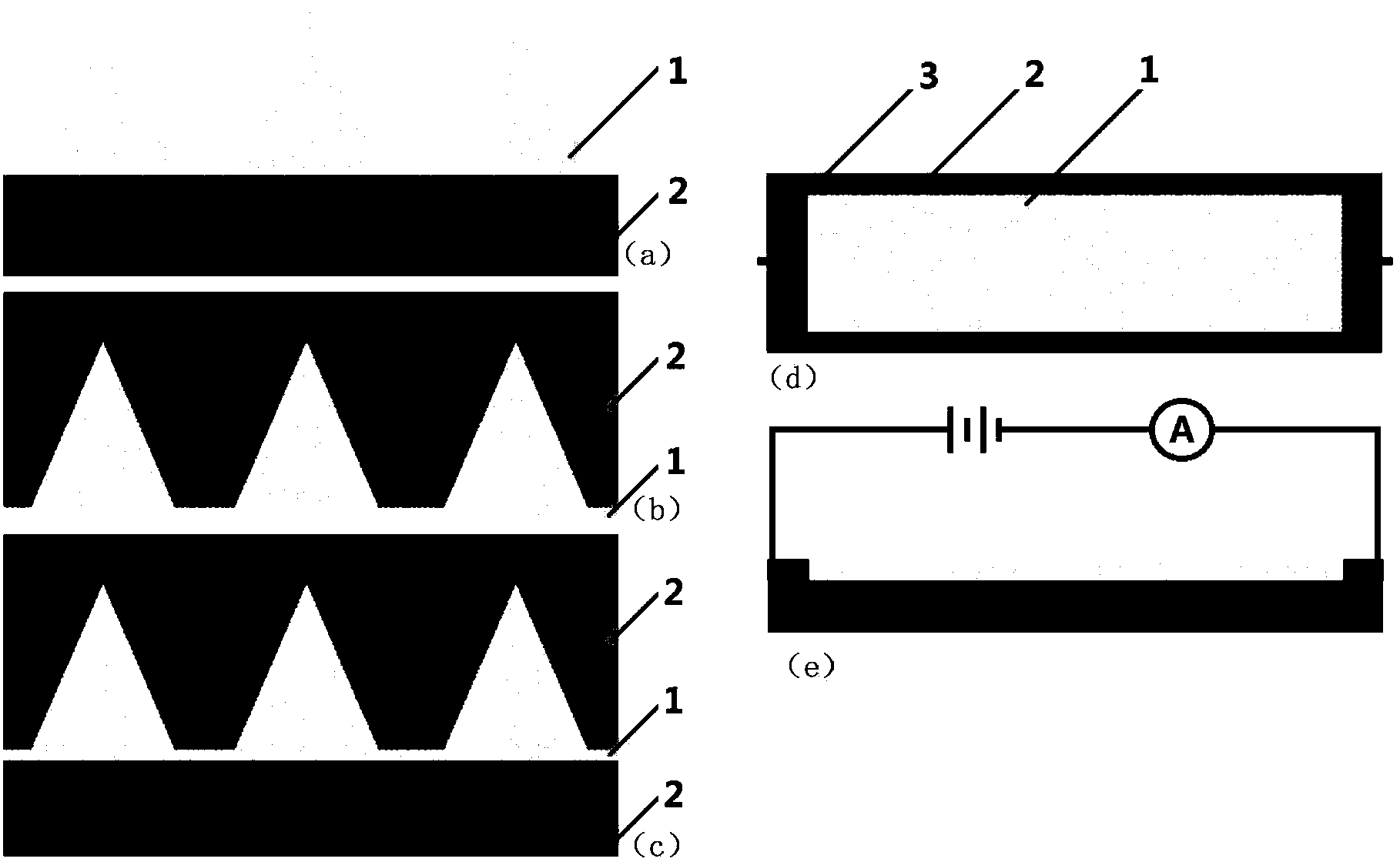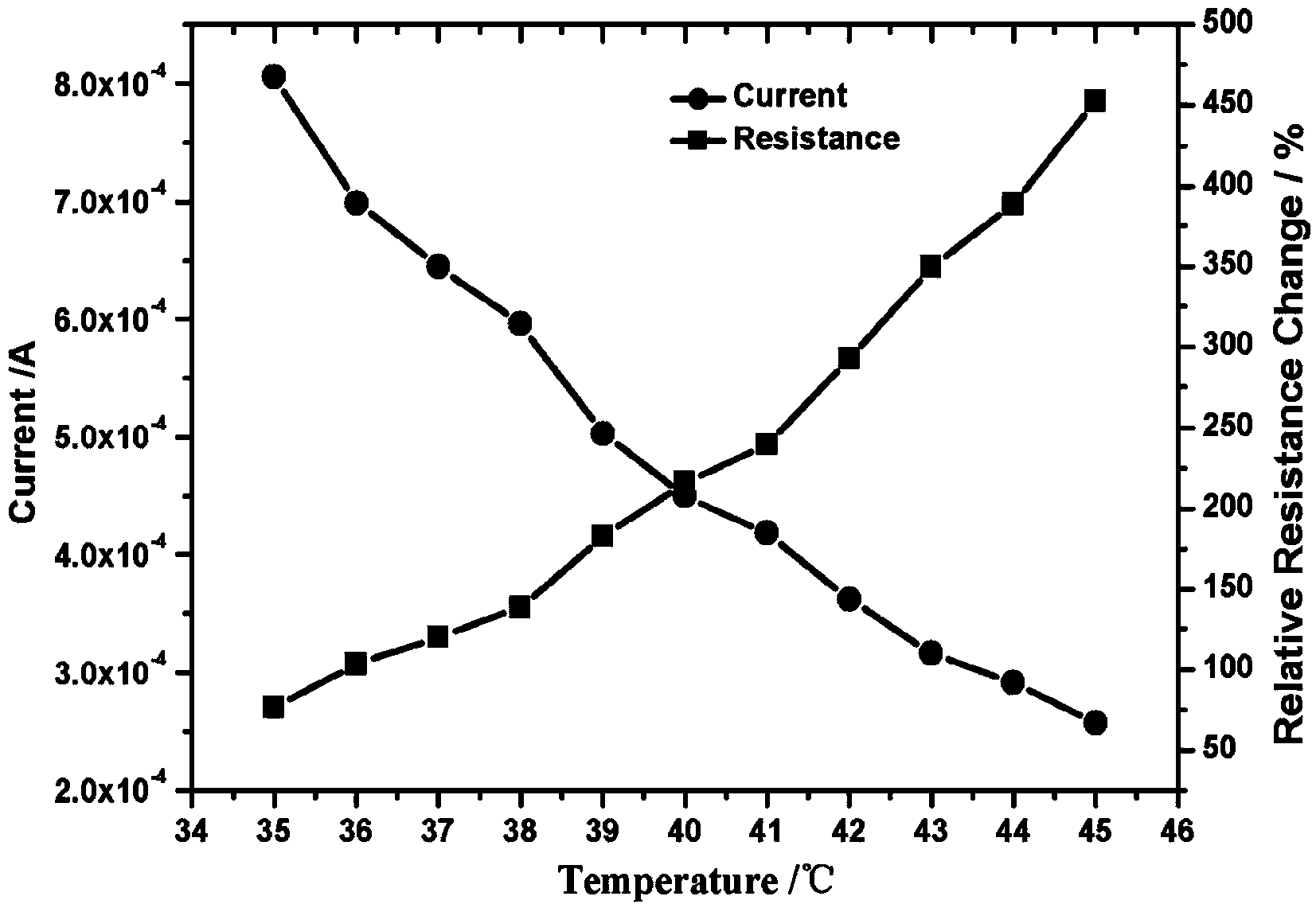Flexible temperature sensor based on graphene nanometer wall and preparing method thereof
A graphene nano wall and temperature sensor technology, applied in the field of sensors, can solve the problems of non-flexible biocompatibility, poor biocompatibility, etc., and achieve the effects of good biocompatibility, convenient processing and simple structure
- Summary
- Abstract
- Description
- Claims
- Application Information
AI Technical Summary
Problems solved by technology
Method used
Image
Examples
Embodiment 1
[0044] Example 1: Fabrication of a graphene nanowall / PDMS composite material temperature sensor and testing of its sensing characteristics
[0045] Step 1: Preparation of graphene nanowalls
[0046] First place the substrate copper foil in acetone, 95vol% ethanol, and pure water for ultrasonic cleaning for 2 minutes, blow dry with nitrogen, and then place it in the vacuum chamber of the tubular CVD system to prepare graphene nanowalls to obtain graphene nanometer walls. wall.
[0047] Step 2: Fabrication of thermal resistors for flexible temperature sensors based on graphene nanowalls
[0048] Put the obtained graphene nano-wall in the ferric nitrate corrosion solution to completely remove the copper, then use the prepared PDMS with a thickness of 50um to pick up and combine the graphene nano-wall from below, and then use the obtained structure. Repeated cleaning with ionized water, hydrochloric acid, etc., and drying with nitrogen gas to obtain a graphene nanowall / polymer (...
Embodiment 2
[0053] Example 2: Fabrication of PDMS / graphene nano-wall composite temperature sensor and testing of its sensing characteristics
[0054] Step 1: Preparation of graphene nanowalls
[0055] First place the substrate copper foil in acetone, 95vol% ethanol, and pure water for ultrasonic cleaning for 2 minutes, blow dry with nitrogen, and then place it in the vacuum chamber of the tubular CVD system to prepare graphene nanowalls to obtain graphene nanometer walls. wall.
[0056] Step 2: Fabrication of thermal resistors for flexible temperature sensors based on graphene nanowalls
[0057] The resulting graphene nanowall was spin-coated with a layer of PDMS with a thickness of 50 um, and placed in an oven at 80°C to cure the PDMS to obtain a PDMS / graphene nanowall / two-dimensional copper structure. The resulting structure is repeatedly cleaned with deionized water, hydrochloric acid, etc., and dried with nitrogen to obtain a temperature sensor with a two-layer structure of PDMS / gra...
Embodiment 3
[0062] Example 3: Fabrication of PDMS / graphene nano-wall / PDMS composite material temperature sensor and testing of its sensing characteristics
[0063] Step 1: Preparation of graphene nanowalls
[0064] First place the substrate copper foil in acetone, 95vol% ethanol, and pure water for ultrasonic cleaning for 2 minutes, blow dry with nitrogen, and then place it in the vacuum chamber of the tubular CVD system to prepare graphene nanowalls to obtain graphene nanometer walls. wall.
[0065] Step 2: Fabrication of thermal resistors for flexible temperature sensors based on graphene nanowalls
[0066] The resulting graphene nanowall was spin-coated with a layer of PDMS with a thickness of 50 um, and placed in an oven at 80°C to cure the PDMS to obtain a PDMS / graphene nanowall / two-dimensional copper structure. Then the resulting structure was repeatedly cleaned with deionized water, hydrochloric acid, etc., and dried with nitrogen gas to obtain a two-layer structure of PDMS / graph...
PUM
 Login to View More
Login to View More Abstract
Description
Claims
Application Information
 Login to View More
Login to View More - R&D
- Intellectual Property
- Life Sciences
- Materials
- Tech Scout
- Unparalleled Data Quality
- Higher Quality Content
- 60% Fewer Hallucinations
Browse by: Latest US Patents, China's latest patents, Technical Efficacy Thesaurus, Application Domain, Technology Topic, Popular Technical Reports.
© 2025 PatSnap. All rights reserved.Legal|Privacy policy|Modern Slavery Act Transparency Statement|Sitemap|About US| Contact US: help@patsnap.com


